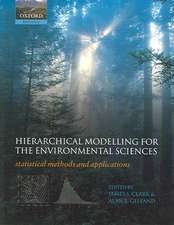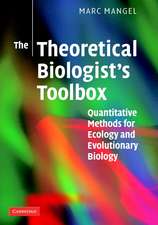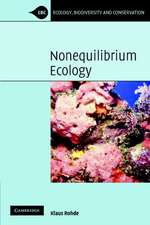Fennoscandian Tundra Ecosystems: Part 1 Plants and Microorganisms: Ecological Studies, cartea 16
P. Kallio Editat de Frans Emil Wielgolaski T. Rosswallen Limba Engleză Paperback – 21 dec 2011
Din seria Ecological Studies
- 18%
 Preț: 1118.93 lei
Preț: 1118.93 lei -
 Preț: 553.71 lei
Preț: 553.71 lei - 18%
 Preț: 1680.55 lei
Preț: 1680.55 lei - 18%
 Preț: 1003.38 lei
Preț: 1003.38 lei - 20%
 Preț: 1004.69 lei
Preț: 1004.69 lei -
 Preț: 480.62 lei
Preț: 480.62 lei - 5%
 Preț: 752.26 lei
Preț: 752.26 lei - 15%
 Preț: 643.99 lei
Preț: 643.99 lei - 15%
 Preț: 644.18 lei
Preț: 644.18 lei - 15%
 Preț: 652.49 lei
Preț: 652.49 lei - 18%
 Preț: 789.83 lei
Preț: 789.83 lei -
 Preț: 382.36 lei
Preț: 382.36 lei - 15%
 Preț: 643.48 lei
Preț: 643.48 lei - 15%
 Preț: 646.30 lei
Preț: 646.30 lei - 15%
 Preț: 634.32 lei
Preț: 634.32 lei -
 Preț: 384.86 lei
Preț: 384.86 lei - 18%
 Preț: 789.98 lei
Preț: 789.98 lei - 15%
 Preț: 645.14 lei
Preț: 645.14 lei - 15%
 Preț: 649.39 lei
Preț: 649.39 lei - 18%
 Preț: 1005.43 lei
Preț: 1005.43 lei - 18%
 Preț: 949.23 lei
Preț: 949.23 lei - 15%
 Preț: 649.54 lei
Preț: 649.54 lei - 15%
 Preț: 643.34 lei
Preț: 643.34 lei - 15%
 Preț: 649.71 lei
Preț: 649.71 lei - 15%
 Preț: 638.76 lei
Preț: 638.76 lei - 18%
 Preț: 957.62 lei
Preț: 957.62 lei - 18%
 Preț: 1235.25 lei
Preț: 1235.25 lei - 18%
 Preț: 962.18 lei
Preț: 962.18 lei - 18%
 Preț: 949.23 lei
Preț: 949.23 lei - 15%
 Preț: 660.68 lei
Preț: 660.68 lei -
 Preț: 397.76 lei
Preț: 397.76 lei - 15%
 Preț: 638.24 lei
Preț: 638.24 lei - 18%
 Preț: 942.31 lei
Preț: 942.31 lei - 18%
 Preț: 1232.57 lei
Preț: 1232.57 lei - 15%
 Preț: 651.34 lei
Preț: 651.34 lei - 18%
 Preț: 952.72 lei
Preț: 952.72 lei - 18%
 Preț: 1834.27 lei
Preț: 1834.27 lei - 18%
 Preț: 1229.10 lei
Preț: 1229.10 lei -
 Preț: 423.95 lei
Preț: 423.95 lei - 18%
 Preț: 948.92 lei
Preț: 948.92 lei
Preț: 647.59 lei
Preț vechi: 761.87 lei
-15% Nou
Puncte Express: 971
Preț estimativ în valută:
123.92€ • 129.64$ • 102.94£
123.92€ • 129.64$ • 102.94£
Carte tipărită la comandă
Livrare economică 03-17 aprilie
Preluare comenzi: 021 569.72.76
Specificații
ISBN-13: 9783642809392
ISBN-10: 3642809391
Pagini: 388
Ilustrații: XVI, 368 p.
Dimensiuni: 170 x 244 x 20 mm
Greutate: 0.62 kg
Ediția:Softcover reprint of the original 1st ed. 1975
Editura: Springer Berlin, Heidelberg
Colecția Springer
Seria Ecological Studies
Locul publicării:Berlin, Heidelberg, Germany
ISBN-10: 3642809391
Pagini: 388
Ilustrații: XVI, 368 p.
Dimensiuni: 170 x 244 x 20 mm
Greutate: 0.62 kg
Ediția:Softcover reprint of the original 1st ed. 1975
Editura: Springer Berlin, Heidelberg
Colecția Springer
Seria Ecological Studies
Locul publicării:Berlin, Heidelberg, Germany
Public țintă
ResearchCuprins
1. Site Description.- Description of Fennoscandian Tundra Ecosystems.- 2. Abiotic Variables.- Soils of Fennoscandian IBP Tundra Ecosystems.- Climate and Hydrology of Some Fennoscandian Tundra Ecosystems.- 3. Primary Producers.- 3.1. Plant Structure.- Flora and Plant Sociology in Fennoscandian Tundra Areas.- Survey of the Main Plant Communities on Hardangervidda.- Vegetation Mapping at Hardangervidda.- Dispersal and Primary Establishment of Vegetation.- Comparison of Plant Structure on Grazed and Ungrazed Tundra Meadows.- Plant Phenology of Fennoscandian Tundra Areas.- Measurement of Leaf Areas and Leaf Angles of Plants at Hardangervidda, Norway.- 3.2. Biomass and Production.- Plant Biomass and Primary Production of Fennoscandian Subarctic and Subalpine Forests and of Alpine Willow and Heath Ecosystems.- Primary Productivity of Alpine Meadow Communities.- Growth in Populations of Andromeda polifolia on a Subarctic Mire.- 3.3. Plant Processes.- Weight Increase of Some Lichens as Related to Carbon Dioxide Exchange and Thallus Moisture.- CO2 Exchange and Growth of Rhacomitrium lanuginosum and Dicranum elongatum.- On the Effect of Continuous Light on Photosynthesis in Mosses.- Acclimatization Effect in Photosynthesis and Respiration.- CO2 Exchange in Norwegian Tundra Plants Studied by Infrared Gas Analyzer Technique.- Photosynthesis and Respiration of Plants Studied by Field Technique at Hardangervidda, Norway.- The Seasonal Pattern of Photosynthesis of Some Vascular Plants on a Subarctic Mire.- Energy Content and Use of Solar Radiation of Fennoscandian Tundra Plants.- Distribution of 14C Photosynthates in Norwegian Alpine Plants.- Pigment Structure of Vascular Plants, Mosses, and Lichens at Hardangervidda, Norway.- 4. Decomposers.- Decomposition, Microbiology, and EcosystemAnalysis.- Biomass and Production of Soil and Litter Fungi at Scandinavian Tundra Sites.- Microfungal Populations of the Abisko Area, Northern Sweden.- Bacterial Populations of Some Fennoscandian Tundra Soils.- Comparisons ofDecomposition Rates Measured by Means of Cellulose.- Plant Litter Decomposition at Fennoscandian Tundra Sites.- Carbon Losses from Tundra Soils.- 5. Nutrient Cycling.- Nitrogen Fixation in Lichens at Kevo, North-Finland.- Nitrogen Fixation by Bacteria and FreeLiving Blue-Green Algae in Tundra Areas.- Mineral Content of Tundra and Forest Tundra Plants in Fennoscandia.- Analysis of Precipitation at Fennoscandian Tundra Sites.- Organic Compounds in Alpine Plants.- The Input and Significance of Particulate Terrestrial Organic Carbon in a Subalpine Freshwater Ecosystem.
















